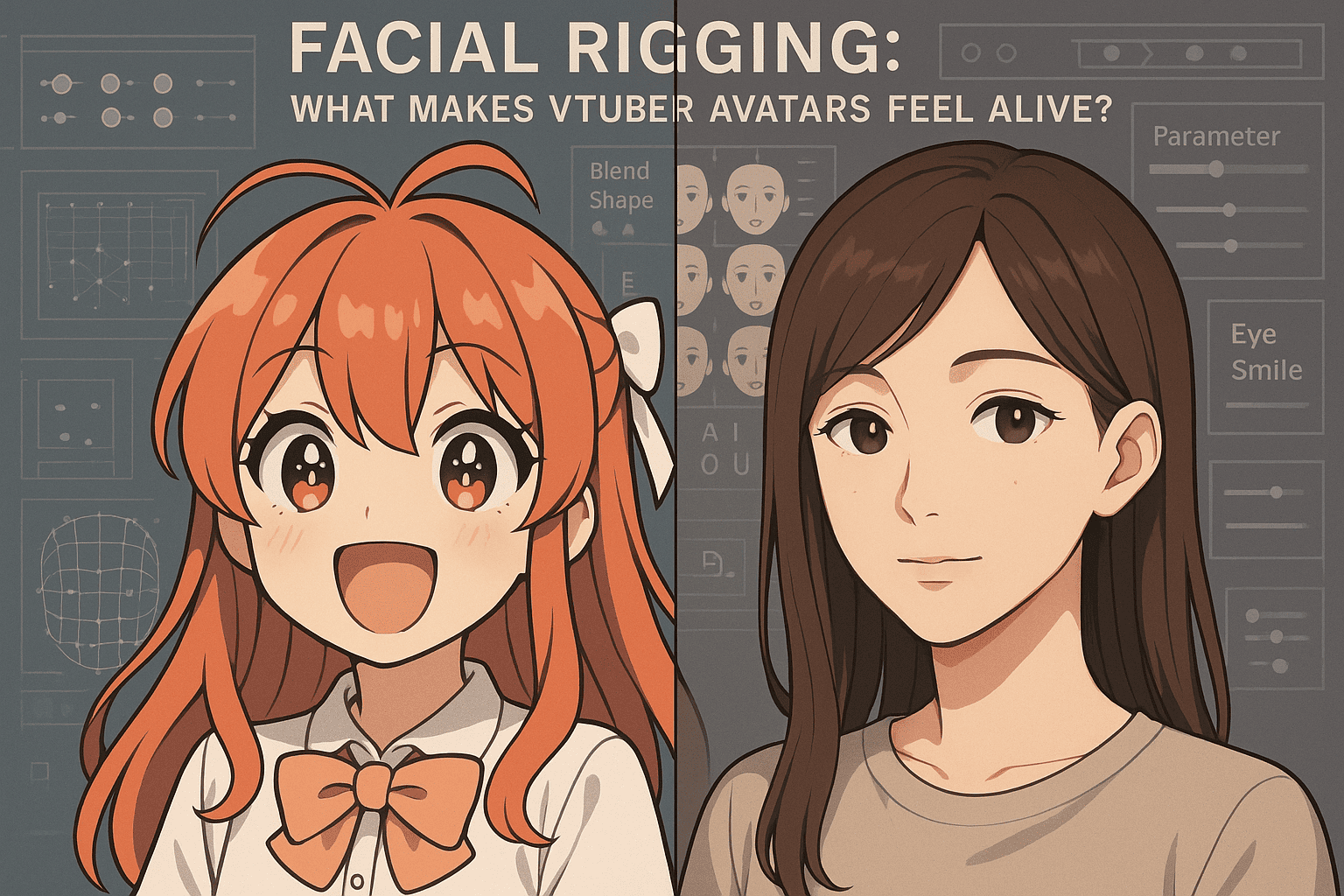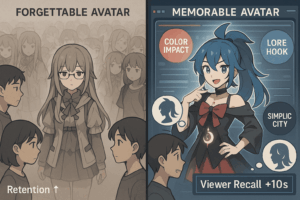Have you ever watched a VTuber stream and felt like the avatar was actually alive, blinking, smiling, reacting with emotion, almost as if it were human? That magic isn’t just art or software. It’s something deeper: facial rigging. Facial rigging is the unsung hero behind the most compelling VTuber avatars. It’s what makes a static illustration emote, connect, and feel. From subtle eyebrow twitches to exaggerated anime reactions, rigging transforms your character from a drawing into a living, breathing persona.
In this guide, we’re pulling back the curtain on what makes VTuber faces so expressive. Whether you’re a new creator exploring your first model or a viewer curious about how it all works, understanding facial rigging is key to appreciating and creating avatars that truly come alive.
What Is Facial Rigging in VTubing?
In simple terms, facial rigging is the process of giving a static 2D or 3D VTuber avatar a flexible digital “skeleton” that enables facial movement. Think of it like wiring up a puppet so that it smiles when you smile or blinks when you blink.
For VTubers, this is the core of emotional realism. It bridges the gap between performer and avatar, syncing real-life expressions with the virtual face. Without good rigging, even the most beautiful avatar can feel stiff or uncanny.
The Two Main Types of Facial Rigging
- Live2D Rigging (for 2D avatars)
- Utilizes deformers, parameters, and keyforms to simulate facial motion on a flat image.
- Ideal for anime-style avatars.
- Requires delicate control over warp deformations to avoid distortions.
- 3D Facial Rigging (for 3D avatars)
- Builds a facial control system within a 3D mesh using bones, blend shapes (morph targets), or both.
- Works with real-time facial capture via webcams or iPhone ARKit.
- Enables more nuanced expressions, lip-syncing, and head turns.
Why Facial Rigging Is the Brain Behind Your Avatar’s Charm?
Your VTuber model might have the perfect hair physics or detailed outfit, but it’s the fact that your audience emotionally connects with. Facial rigging breathes life into your avatar by:
- Enhancing emotional expression – smiles frowns, smirks, and eye rolls all become possible.
- Creating immersive storytelling – subtle reactions can drive narratives or comedic timing.
- Improving audience retention – viewers stay longer when your avatar feels responsive and relatable.
Without VTuber rigging, even the most charismatic performer would be trapped behind a motionless mask.
Key Components of VTuber Facial Rigging
Let’s look deeper into what actually makes up the facial rig of a VTuber avatar.
1. Blend Shapes (3D VTubers)
Also called shape keys or morph targets, blend shapes allow parts of a mesh to shift into different poses (e.g., smile, raise eyebrows, puff cheeks). These shapes are blended in real-time based on your facial tracking data.
- Great for avatar realism
- Can combine multiple shapes (e.g., blink + smile + turn)
- Essential for dynamic expression without overloading the model with bones
2. Deformers and Parameters (Live2D)
For 2D avatars, Live2D rigging uses deformers (warping tools) to bend parts of the artwork, and parameters to control those deformations.
- Each parameter corresponds to a specific movement (e.g., eyeBlink_L, mouthOpenY)
- Deformers allow smooth interpolation between states
- The quality of the deformer setup dictates fluidity and realism
3. Bone-Based Rigging (Mainly in 3D)
While blend shapes handle detailed facial expressions, bones can also drive movement—especially jaw, neck, or eyelid motion. Advanced rigs might combine bones with blended shapes for maximum control.
- Efficient for real-time performance
- Compatible with physics-based facial rigs
- Useful in gaming-style 3D models (e.g., Unity or Unreal VTubers)
Face Tracking and Facial Rigging: Two Sides of the Same Coin
Facial rigging doesn’t work alone; it needs facial tracking input to bring it to life. Most VTubers use software like VTube Studio, VSeeFace, or Animaze that reads webcam data or iPhone facial capture to track:
- Eye direction and blinking
- Brow movement
- Mouth shapes (visemes)
- Cheek puff or jaw drop
- Head tilt and rotation
The rig responds to this data, translating real-time micro movements into avatar motion. A well-rigged face will feel fluid, subtle, and alive even with basic camera input.
What Makes a Good VTuber Facial Rig?
All rigs are not created equal. A basic VTuber rig might include only blinking and mouth movement, while a high-end custom rig can feature:
- Independent eyebrow control
- Upper and lower eyelid movement
- Jaw and cheek puffing
- Tongue movement (yes, really)
- Angry, sad, joy, and surprise presets
- Eye squint vs blink differentiation
- Face puff, smile lines, wrinkle simulation
If you’re commissioning or DIY-ing your VTuber avatar, ask these questions:
- Can your rig support phoneme-based lip-syncing?
- Are emotions like joy or frustration visible at a glance?
- Do facial transitions feel smooth or jerky?
- Can it blend expressions (e.g., sad + tired)?
A well-built facial rig is a long-term investment in your brand as a VTuber.
Realism vs Stylization: What’s Best for You?
One of the most debated aspects of VTuber avatars is whether they should aim for realism or stay stylized. Your facial rig plays a central role in this decision; it determines how expressive, believable, or iconic your character feels on screen.
Stylized Avatars:
Stylized avatars often use exaggerated deformations—big blinks, oversized tears, and heart-shaped mouths. They’re ideal for high-energy, comedic, or anime-style content where exaggeration boosts entertainment. These rigs are often more lightweight and fun to animate, especially with Live2D rigging.
Realistic Avatars:
On the other hand, realistic avatars demand subtlety. They require layered rigging and advanced blend shapes to capture micro-expressions, emotional nuance, and natural human behavior. This realism builds intimacy, perfect for immersive roleplay, dramatic storytelling, or ASMR, where even the smallest expression matters.
Ultimately, it’s about how you want your audience to feel. Do you want them to laugh with you, or believe in you? Choosing between stylized charm and avatar realism isn’t just aesthetic, it’s strategic branding.
How Much Does Facial Rigging Cost?
Rigging prices vary wildly depending on complexity:
| Rig Type | Estimated Cost Range |
| Basic Live2D Facial Rig | $80 – $200 |
| Advanced Live2D Rig | $300 – $700+ |
| Simple 3D Facial Rig | $150 – $400 |
| Advanced 3D Rig (blend shapes + bones) | $800 – $2000+ |
Pro tip: Look for portfolio-ready riggers on platforms like Booth.pm, Skeb, or Fiverr, but always ask for facial rig demo videos before you commission. If you prefer a streamlined, one-stop solution, services like TheVTubers.com offer customizable, fully rigged avatars ready to deploy.
How Facial Rigging Affects VTuber Branding?
Facial rigging does far more than animate your avatar—it shapes your brand identity. Every blink, smirk, and subtle brow raise tells your audience who you are, even before you speak. Rigging is not just a technical layer; it’s an emotional language that defines your digital presence.
Rigging Creates Emotional First Impressions
The way your avatar expresses itself sets the emotional tone of your content. Want to be cozy and comforting? Or fierce and chaotic? Your facial rig says it before you do.
- Soft eyes and gentle blinks → warm, approachable, great for chill or slice-of-life streams.
- Sharp brows and exaggerated smirks → energetic, and sarcastic, ideal for bold or comedic VTubers.
- Minimal or robotic movement → mysterious, emotionless, fitting for sci-fi or narrative-driven channels.
Iconic Rigs Build Recognizability
Successful VTubers don’t just have good models, they have signature expressions. These facial movements become part of the brand across content types.
- Ironmouse: bright-eyed sparkle and hyperactive joy.
- Kuzuha: subtle smirks with cool, aloof charm.
- These expressions show up in thumbnails, fan art, and even merchandise, becoming instantly recognizable.
Consistency Strengthens Your Brand
When your avatar expresses itself the same way across platforms, it builds trust and familiarity.
- Your audience learns to associate certain expressions with your personality.
- Emotional consistency improves clip quality and stream highlights.
- Reactions feel more “you,” even in short-form or collaborative content.
The Rise of AI-Assisted Facial Rigging
In 2025, we’re also seeing the rise of AI-assisted facial rigging, tools that auto-generate blend shapes or optimize deformations based on facial scans or webcam data. While not perfect yet, these tools are speeding up production for indie creators and hobbyists.
Some notable AI-supported tools include:
- DeepMotion (3D motion capture + face)
- AccuRIG by Reallusion
- EmbodyMe (VRM support with AI lip sync)
- ReadyPlayerMe’s blend shape kits
These can be great entry points if you want to experiment with VTubing before investing in high-end custom rigs.
Final Thoughts
When fans fall in love with a VTuber, it’s not just about the voice or the avatar design; it’s about how alive the character feels. Facial rigging is what turns that feeling into reality. For new creators, investing in the right rig can elevate even a simple model into something truly memorable. If you’re a viewer, the next time your favorite VTuber blinks, smirks, or breaks into a smile, remember—there’s a deep layer of art and tech making that magic happen. And for those dreaming even bigger, keep an eye out for Phygital, an upcoming offering that connects the digital and physical world, bringing fully custom VTuber avatars to life with matching collectible figures. It’s still in pre-launch, but it’s a glimpse into the future of avatar identity.



